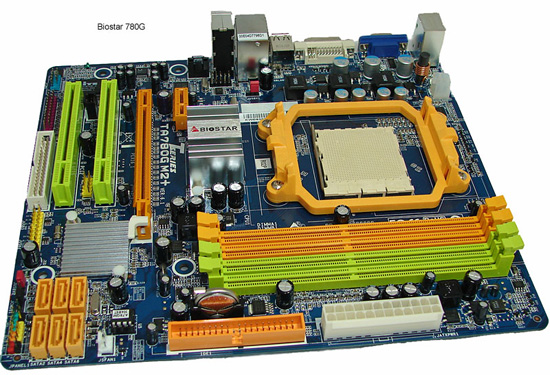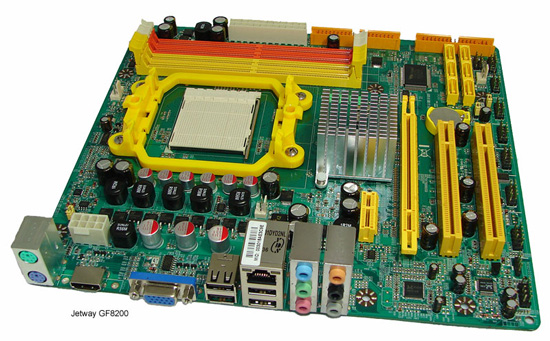Motherboards
Our case dictates a uATX form factor motherboard. Fortunately for us, the choices are numerous for the socket AM2+ format we require. Since AMD has concentrated on (or been forced to) the low end sector the past couple of years, the chipset and motherboard suppliers have responded with some very good chipsets following the AMD 690G chipset launch last year. The two primary chipsets I focused on are the AMD 780G and NVIDIA GeForce 8200/8300. The supply situation is better with the AMD 780G at this point but the GF8200/8300 is a very completive offering.
Either chipset would work for our requirements. In fact, if these systems were not using discrete video cards, I would have chosen the 780G based upon the performance of its IGP. The GF8200 holds an advantage by offering 8-channel LPCM audio over HDMI compared to two-channel for the 780G, but with recent driver changes turning off 6-channel LPCM output, NV is effectively neutering their chipset for reasons we cannot explain. In the end, based on using a discreet graphics card, either chipset was fine for our configuration.
Now that I had settled the chipset question (sort of), it was time to find the right board for the right price. The de facto standard in this market sector right now is the Gigabyte GA-MA78GM-S2H, and rightfully so. It would have been very easy to just select that motherboard and end my search quickly. However, in this market sector there are alternate choices and I like to spread my money around to other suppliers at times. I had a request from a couple of family members to build them basic "SOHO" machines so I had a little leeway in ordering several uATX boards and then choosing which one I would use.


The Gigabyte board was first on the list, but it ended up with Anand for his Home Theater construction masterpiece. Even so, some very competent choices stayed at home. The Jetway 780G PA78GT3-DG and GF8200 PN78SM3-HL, Biostar TA780G M2+, Sapphire PI-AMDRS780G, and ASRock 780G A780FullDisplayPort all were used in personal system buildups. I would like to mention that the J&W JW-RS780UVD-AM2+ and Zotac GF8300 were highly sought after based upon test results but those products were not available in the US at time of purchase. Currently, the Jetway and Biostar products are in and out of stock at various e-tailors, but the others listed were in stock at several locations today.
I planned on a smooth "exit stage left" routine without saying which motherboards are staying in my personal systems, but I am sure somebody would have noticed the lack of commitment on the subject. In the end, the Biostar 780G is in my system and the Jetway GF8200 board is in my daughter's system. How did I come to that decision? It came down to the location of the PCI Express x1 slot on each board. This small design difference changed the original plan of installing the GF8200 board in my system and I will go over that decision shortly.
The Jetway 780G and Sapphire 780G are in systems for my parents, who are both active computer nuts well into their seventies now. The ASRock 780G product ended up in another system for testing. I will explain that in another blog shortly. I will sum up the motherboard choices by simply stating that there are other choices in the market worth considering before making a purchasing decision. These brands listed today may not be from Tier-1 suppliers, nor offer the greatest amount of features or overclocking capabilities, but so far they have performed extremely well as the heart and soul in these jack-of-all trades systems.










33 Comments
View All Comments
JarredWalton - Wednesday, May 28, 2008 - link
You might want to do a bit more http://en.wikipedia.org/wiki/MicroATX">research. Just as all ATX boards aren't identical in size, there is some leeway in how big a micro-ATX board can be. Maximum size is 9.6" x 9.6", but they can be much smaller than that as well.While the correct abbreviation is µATX, mATX and uATX are synonyms that are equally valid in our modern PC vernacular. (Gasp! You mean Newegg is wrong!? Yup. It happens. Or you could consider it a mere difference of opinion, where Newegg is trying to redefine uATX to mean something other than mATX.)
DXRick - Thursday, May 29, 2008 - link
Thanks. Sorry for being stupid.FireTech - Tuesday, May 27, 2008 - link
A very interesting 'article' Gary, with insight into the world of a reviewer but nicely balanced with the requirements of the typical cash conscious geek/husband/parent!I'm certainly looking forward to part two.